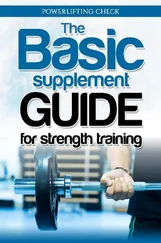WHAT TO DO ABOUT DOMS
Some soreness is to be expected and, for the most part, time is your best bet.
There are other solutions you can try.
✓ Take an over-the-counter painkiller such as ibuprofen (make sure you talk to your doctor first about any other medications you’re on)
✓ Try using a muscle relief cream such as Bengay or Sombra
✓ Take a hot bath or shower
✓ Get a massage
It’s also a good idea to keep moving, even if you’re sore. Keeping your muscles warm will help you feel better, even if it doesn’t speed up the healing process. Keep in mind that, if you can barely move after a workout, you likely overdid it and should back off on your weights and workouts.
REST DAYS
Rest is just as important as your workout. It’s only during the rest days that your muscles grow. Your workout is the stimulus, and your body responds during recovery periods.
A rest day doesn’t necessarily mean you sit around doing nothing. In fact, doing some movement will actually help you make progress. Your body needs circulation to bring nutrients to your muscles, so movement actually helps the process.
How much rest you need is based on a number of factors including fitness level, age, other activities you may be involved in, sleep habits, and more.
In this program, you’ll have scheduled rest days, but it’s important to know what works for you. If you’re very sore, consider taking an extra day or two off from exercise and get back to it when the soreness is gone.
The last thing you want is to overdo it and end up with a longer recovery period, although it’s usually okay to do some light movement if you’re feeling stiff rather than sore.
Doing some light cardio on rest days is a great way to stay active and keep the blood moving in your body.
PAIN VS. DISCOMFORT
You’ve probably heard plenty of sayings about exercise like, “No pain, no gain.” But, in the world of fitness there’s a big difference between the effort it takes to lift weights and actual pain.
Yes, your muscles may burn as you’re lifting weights during the exercise, and that’s a normal feeling that should go away when you stop. But pain during an exercise is entirely different and a sign that you may be doing a movement your body just doesn’t like.
If you feel any sharp pains in your joints during an exercise, that’s a sign to stop and either change how you’re doing the move or skip it completely.
Other issues to watch out for is chronic pain, such as tendinitis, which you may feel during the workout and after. This could be due to an overuse injury or some other condition, and you should check with your doctor before you keep exercising.
If anything doesn’t feel right, err on the side of caution and stop what you’re doing. It may take some time to get used to the exercises before you know what’s normal discomfort and what’s an injury or situation that may require a doctor’s attention.
Chapter 5
Exercise Guidelines for Seniors
Now, you know that the government and other entities like to tell us just how much exercise we need to be healthy, lose weight, etc. Seniors are no exception, but trying to actually follow these “rules” and adapt them to your life can be downright confusing.
The Office of Disease Prevention and Health Promotion (ODPHP) regularly updates the Physical Activity Guidelines for Americans, grouping it according to age and fitness level. You can find the full guidelines at https://health.gov/paguidelines/second-edition/.
I’m going to break it down so you know what the guidelines are and then how to adapt those guidelines for your particular situation. Every person varies, and we’re all starting from different places.
The guidelines are just that, a rough outline of what to shoot for, not rules that you must follow. Remember, this is your body and you know it better than anyone else, so never be afraid to adjust anything that doesn’t feel good.
In addition, the guidelines don’t always address each person’s fitness level. For example, the general recommendations below suggest 2.5 to 5 hours a week of exercise. That may be a good timeline to shoot for if you’ve been working out for a while but, if you’re new, you might need to start with 10 minutes a day and work your way up. General Exercise Guidelines for Older Adults General exercise recommendations
✓ 150 to 300 minutes (2.5 to 5 hours) per week unless you have physical conditions that may hamper your ability to exercise, in which case do as much as you can to avoid being sedentary Cardio exercise such as walking, swimming, or cycling
✓ Experts recommend you do cardio about 3 days a week at a moderate intensity or, if you’re a regular exerciser, you can mix moderate intensity (level 5 on a scale of 1 to 10) and vigorous-intensity workouts (level 7 or 8 on a scale of 1 to 10) Strength training
✓ Exercises that work all the major muscle groups at least 2 times a week Flexibility training
✓ Doing regular flexibility exercises at least 2 to 3 times a week allows your joints to move more freely through a full range of motion, thus reducing your chances of injuries
Let’s break down these guidelines into what it would look like in real life.
CARDIO EXERCISE
While we’ll focus more on strength training throughout the book, cardio exercise is another important part of getting stronger and being able to do more in your life. You may think that cardio involves high-impact activities such as running, jumping, or high-intensity interval training, but at its most basic, cardio exercise is simply any rhythmic movement you do for an extended period of time.
Here are just some of the activities you have to choose from:
✓ Walking
✓ Jogging
✓ Running
✓ Tennis
✓ Pickleball
✓ Basketball
✓ Swimming
✓ Cycling
✓ Vigorous yard work or housework (think raking leaves or mopping the floor)
✓ Hiking
✓ Active yoga (vinyasa or power yoga)
✓ Dancing
✓ Exercise classes (aerobics, kickboxing, etc.)
Even chasing the kids or grandkids or tossing a ball in the backyard can count as cardio exercise.
The idea with cardio is to work just a bit out of your comfort zone, depending on your fitness level.
Think of a scale of 1 to 10, like the one below:
Perceived Exertion Chart
Level 1:I’m lounging around watching TV and feeling great.
Level 2:I’m moving around a little and feel just fine.
Level 3:I’m taking a leisurely stroll or puttering around and could probably do this all day.
Level 4:I’m moving faster now and I might even start sweating soon. This is starting to feel suspiciously like exercise.
Level 5:Now I know I’m exercising, but I’m only a little out of my comfort zone. I can still talk and I’m okay.
Level 6:I’m working harder now and can still talk, but it’s becoming more difficult. I’m totally exercising now.
Level 7:Okay, now I’m breathing harder and I can talk, but only in short sentences.
Level 8:I’m working really hard and can only stay at this level for a short time. I could huff out a word or two if forced.
Level 9:I cannot talk. At all. I think I might be dying.
Level 10:I am dead.
Obviously this is a little tongue in cheek and not an official version of a perceived exertion chart, but it gives you an idea of how the exercise feels to you and what level of intensity you’re at. You generally want to shoot for around level 5 or 6 for a moderate-intensity workout.
Читать дальше












